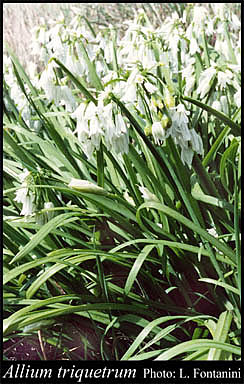- Reference
- Sp.Pl. [Linnaeus] 1:300 (1753)
- Conservation Code
- Not threatened
- Naturalised Status
- Alien to Western Australia
- Name Status
- Current
Bulbaceous, perennial, herb, to 0.3 m high. Fl. white, Aug to Oct.

Distribution
- IBRA Regions
- Avon Wheatbelt, Jarrah Forest, Swan Coastal Plain, Warren.
- IBRA Subregions
- Katanning, Northern Jarrah Forest, Perth, Southern Jarrah Forest, Warren.
- IMCRA Regions
- Central West Coast, Leeuwin-Naturaliste, WA South Coast.
- Local Government Areas (LGAs)
- Albany, Armadale, Augusta Margaret River, Boddington, Bridgetown-Greenbushes, Busselton, Dardanup, Donnybrook-Balingup, Fremantle, Kojonup, Manjimup, Murray, Narrogin, Nedlands, Perth, Plantagenet, Vincent, Waroona.
Management Notes (for the Swan NRM Region)
General Biology. Growth form. Geophyte. Life form. Bulb. Reproduction. Offsets, seed. Dispersal. Water, soil, possibly ants. Time to first flowering. 2 years. Seedbank persistence. Medium, 1-5 years. Fire response. Generally survives fire.
Additional information. Origin. Southern Europe, North Africa. History of use/introduction. Naturalised in South Australia by 1909.
Suggested method of management and control. Spot spray metsulfuron methyl 0.2 g/15 L + Pulse® (or 2.5 - 5g /ha + Pulse®) or 2,2 DPA 5 g/L+ Pulse®. Apply just on flowering at bulb exhaustion. Read the manufacturers' labels and material safety data sheets before using herbicides. For further information consult the Australian Pesticides and Veterinary Medicines Authority to determine the status of permits for your situation or state.
Management Calendar
| Calendar Type | Jan | Feb | Mar | Apr | May | Jun | Jul | Aug | Sep | Oct | Nov | Dec | Comments |
|---|---|---|---|---|---|---|---|---|---|---|---|---|---|
| Dormant | Y | Y | Y | Y | Y | ||||||||
| Active Growth | Y | Y | Y | Y | Y | Y | Y | ||||||
| Flowering | Y | Y | Y | ||||||||||
| Germination | Y | Y | |||||||||||
| Optimum Treatment | Y | Y |
Legend: Y = Yes, regularly, O = Occasionally, U = Uncertain, referred by others but not confirmed.
References
- Blood, K. (2001) Environmental weeds: a field guide for SE Australia. C.H. Jerram and Associates, Melbourne.
- Brown, K. & Brooks, K. (2002) Bushland Weeds: A Practical Guide to their Management. Environmental Weeds Action Network, Greenwood.
- Dixon, B. & Keighery, G. (1995) Weeds and their control. In Managing Perths bushlands (eds. M. Scheltema and J. Harris). Greening Western Australia, Perth.
- Du Plessis, N. & Duncan G. (1989) Bulbous plants of Southern Africa. Tafelberg Publishers Ltd, Cape Town, South Africa.
- Easton, S.D. & Dixon I.R. (2007) Effectiveness of 2,2-DPA in Controlling Babiana, Ixia and Allium in Native Bushland. Australian Association of Bush Regenerators (WA) Inc. Newsletter., 15 (5).
- Hussey, B.M.J., Keighery, G.J., Dodd, J., Lloyd, S.G. & Cousens, R.D. (2007) Western Weeds. A guide to the weeds of Western Australia. 2nd Edition. The Plant Protection Society of Western Australia, Victoria Park.
- Muyt, A. (2001) Bush invaders of South-East Australia: A guide to the identification and control of environmental weeds found in South-East Australia. R.G. & F.J. Richardson, Melbourne.
- Parsons, W.T. & Cuthbertson, E.G. (2001) Noxious weeds of Australia. 2nd Edition. CSIRO Publishing, Collingwood.
- Pemberton, R.W. & Irving, D.W. (2008) Elaiosomes on weed seeds and the potential for myrmecochory in naturalized plants. Weed Science, 38 (6): 615-619.
- Pritchard, G.H. (1996) Efficacy of herbicides against angled onion in pot trials. In Proceedings of the 11th Australian Weeds Conference, Melbourne (ed. R.C.H. Shepherd). Weed Science Society of Victoria (Inc.), Melbourne.